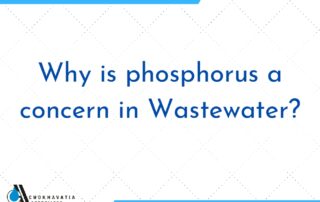Why is Phosphorus a Concern in Wastewater?
Phosphorus Removal from Wastewater
Phosphorus, like other elements, is good for health and is needed in small amounts. However, excessive amounts of phosphorus can cause a type of pollution called eutrophication. It is a process that aggressively stimulates algae and other simple plants. That eventually depletes certain areas of oxygen and creates. That is called “dead zones” in the water. That can lead to the extinction of various aquatic lives and the depletion of healthy flora and fauna. This type of nutrient pollution can cause environmental problems in everything from streams and rivers to lakes and coastal areas. Algae growth from too much phosphorus can corrode water pipes and ultimately affect drinking water quality. Excessive amounts of algae due to phosphorus in bodies of water can also cause skin irritation. Once phosphorus is dissolved in water, it is very difficult to completely remove it.
Methods for Phosphorus Remove from Wastewater?
There are several methods for removing phosphorus from wastewater. The choice of method is often determined by many factors. This may include general characteristics of the water treated city equipment used, desired results, and associated costs.
Chemical Vapor Deposition
This process is most commonly used to remove phosphorus from water. This method usually involves the use of iron and aluminium coagulants. Sometimes calcium hydroxide or lime is used. The introduction of chemicals into the wastewater during the primary sedimentation process is called pre-sedimentation. It is also possible to add chemicals during the post-precipitation or so- it ‘s called “co-precipitation,” process.
Biological Removal
Sometimes this method is used for Different types of bacteria can be added to the water to remove excess phosphorus. Polyphosphate- accumulating organisms (PAOs) are bacteria that can contribute to the phosphorus removal process.
Physical Removal
In some cases, physical removal may be used alone or in combination with other methods. Different types of physical treatment include sand filtration and membrane technology, according to the net industries, chemical removal methods are used more often than biological removal methods.
Chemotherapy has generally proven to be more effective than other treatments. In most cases, it is more cost-effective to use chemical treatments to remove phosphorus.
What are the possible problems to avoid?
Sometimes methods used to treat water do not remove enough phosphorus to make the water safe for the environment. Chemical removal may result in more sludge than normal.
About Chokhavatia Associates
Chokhavatia Associates is a Top-Notch Engineering Consultants & Wastewater Management Company in India. For over 41 years, Chokhavatia Associates has been delivering world-class, award-winning design solutions with all the creativity and innovation that are at the heart of our business. We have worked with 700+ clients on over 1000+ global projects across various Enterprises, Industries, Private sectors, and Governments. Acknowledged as consummate multi-disciplined professionals in our field, we provide a broad range of industry-focused consulting services that address the distinct and unique challenges faced by our clients around the world. Chokhavatia Associates is a leader in full-service engineering, construction, and operations. With its group company Abhinav Enterprise, which is also ISO 9001-2015 certified company, Chokhavatia Associates undertakes Turnkey projects in India and abroad. Building and maintaining trusting partnerships with clients and associates underpins our success we do this by adhering to four fundamental business principles listening carefully, understanding fully designing and creating purposefully, and implementing effectively.
As an Environmental and Structural Consulting firm, we are committed to providing our clients with sound infrastructure, and also helping them in protecting the environment by employing various high-end pollution control technologies and Environmental Management systems. We hold the responsibility to deliver effective conservation solutions which lead to communal safety and the betterment of our society.

